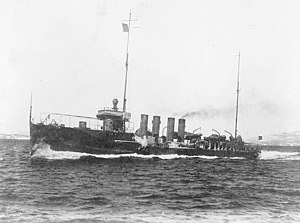 USS Tucker (DD-57), underway while running trials, circa 19 March 1916. Note the ice accumulated amidships.
| |
| History | |
|---|---|
| Name | Tucker |
| Namesake | Commodore Samuel Tucker |
| Ordered | 1913[4] |
| Builder | |
| Cost | $873,155.90 (hull and machinery)[2] |
| Yard number | 226[3] |
| Laid down | 9 November 1914[1] |
| Launched | 4 May 1915[1] |
| Sponsored by | Mrs. William Garty[1] |
| Commissioned | 11 April 1916[1] |
| Decommissioned | 16 May 1921[1] |
| Stricken | 24 October 1936 |
| Identification |
|
| Fate | transferred to U.S. Coast Guard, 25 March 1926,[1] returned 1933, sold on 10 December 1936 and scrapped. |
 Tucker in the service of the United States Coast Guard, c. 1926–1933
| |
| Name | Tucker |
| Acquired | 25 March 1926[1] |
| Commissioned | 29 September 1926[5] |
| Decommissioned | 5 June 1933[5] |
| Identification | Hull symbol:CG-23 |
| Fate | returned to U.S. Navy, 30 June 1933[1] |
| General characteristics | |
| Class and type | Tucker-class destroyer |
| Displacement | |
| Length | 315 ft 3 in (96.09 m)[1] |
| Beam | 29 ft 9 in (9.07 m)[4] |
| Draft | 9 ft 4+1⁄2 in (2.858 m) (mean)[6] |
| Installed power |
|
| Propulsion | |
| Speed | 29.5 knots (54.6 km/h)[1] |
| Complement | 5 officers 96 enlisted[7] |
| Armament |
|
USS Tucker (Destroyer No. 57/DD-57) was the lead ship of her class of destroyers built for the United States Navy prior to the American entry into World War I. The ship was the first U.S. Navy vessel named for Samuel Tucker.
Tucker was laid down by the Fore River Shipbuilding Company of Quincy, Massachusetts, in November 1914 and launched in May 1915. The ship was a little more than 315 feet (96 m) in length, nearly 30 feet (9.1 m) abeam, and had a standard displacement of 1,090 long tons (1,110 t). She was armed with four 4 in (100 mm)/50 caliber guns and had eight 21 inch (533 mm) torpedo tubes. Tucker was powered by a pair of steam turbines that propelled her at up to 29.5 knots (54.6 km/h).
After her April 1916 commissioning, Tucker sailed in the Atlantic and the Caribbean. After the United States entered World War I in April 1917, Tucker was part of the second U.S. destroyer squadron sent overseas. Patrolling the Irish Sea out of Queenstown, Ireland, Tucker made several rescues of passengers and crew from ships sunk by U-boats. For her part in rescuing crewmen from the Dupetit-Thouars in August 1918, Tucker received a commendation from the Préfet Maritime. In June, Tucker was transferred to Brest, France, and spent the remainder of the war there.
Upon returning to the United States near the end of 1918, Tucker underwent repairs at the Boston Navy Yard. After a New England recruiting tour through October 1919, she was placed in reduced commission and then decommissioned in May 1921. In March 1926, Tucker was transferred to the United States Coast Guard to help enforce Prohibition as a part of the "Rum Patrol". She operated under the name USCGC Tucker (CG-23) until 1933; during her Coast Guard service, she was the first American ship to arrive at the crash site of Navy airship Akron. After her transfer back to the Navy later in 1933, the ship was renamed DD-57 to free the name Tucker for another destroyer. She was sold for scrap and hulked in December 1936.
- ^ a b c d e f g h i j k l Naval History & Heritage Command. "Tucker". DANFS. Retrieved 22 April 2009.
- ^ "Table 21 - Ships on Navy List June 30, 1919". Congressional Serial Set. U.S. Government Printing Office: 762. 1921.
- ^ "Tucker (6105790)". Miramar Ship Index. Retrieved 22 April 2009.
- ^ a b c Gardiner, pp. 122–23.
- ^ a b Cite error: The named reference
USCGwas invoked but never defined (see the help page). - ^ "Table 10 - Ships on Navy List June 30, 1919". Congressional Serial Set. U.S. Government Printing Office: 714. 1921.
- ^ "Table 16 - Ships on Navy List June 30, 1919". Congressional Serial Set. U.S. Government Printing Office: 749. 1921.